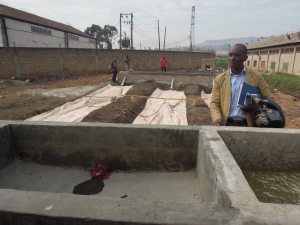
Biogas production takes off at Wambizzi abattoir in Kampala
Written by Vianney Tumwesige and Kristina Roesel
Generating biogas from organic waste could provide two important benefits addressing public health challenges: it can generate clean power (methane for cooking and electricity) as well as reduce the pathogen burden at the slaughter house premises leading to less cross-contamination and rendering slaughter waste into a product safe to use as fertilizer or even animal feeds.

Abattoir manager Simon Lubega at the construction site in early January 2015 when the balloons were just starting to fill up. (ILRI/Kristina Roesel)
Construction works started in early November 2014 and were led by Vianney Tumwesige (Green Heat Uganda). The work took longer than planned as the workers had to dig pits for the ballons through layers of 30 years of pig hair! In the first week of January 2015, three flexible balloon digesters were installed at Wambazzi abattoir. These ballons consist of a narrow and long tank with an average length to width ratio of 5:1. The inlet and outlet of the digester are located at opposite ends kept above ground, while the remaining parts of the digester is buried in the ground in an inclined position of 2-5% to facilitate gravity flow. As fresh substrate is added from the inlet, the digestate flows towards the outlet at the other end of the tank. Support staff at Wambizi mix over 150-200kg of pig manure with equal amount of water before the slurry is fed into the digester through a funnel. The digesters were fed until they were at 2/3 of the digester capacity and gas production started at the end of 1st week of Feb 2014 and quantities will be documented with the help of gasometers. The quality of the gas will be analysed by Green Heat.

The balloons three weeks later and two thirds of the digesters were filled with gas. Vianney Tumwesige: “Wambizzi is a rocket!” (Green Heat/Vianney Tumwesige)
Biological samples are collected by the project partner Central Diagnostic Laboratory (COVAB, Makerere University) to monitor the burden of zoonotic pathogens in the slaughter house (on meat but also floors, hands and equipment) as well as from the in- and outlets of the biogas digester. We are assuming that numbers will decrease after the intervention.
This project is a collaboration between the ILRI-led projects „More pork by and for the poor“ funded by Irish Aid under the CGIAR Research Program on Livestock and Fish and the ‘Safe Food, Fair Food’ project funded by BMZ/GIZ under the CGIAR Research Program on Agriculture for Nutrition and Health.




















